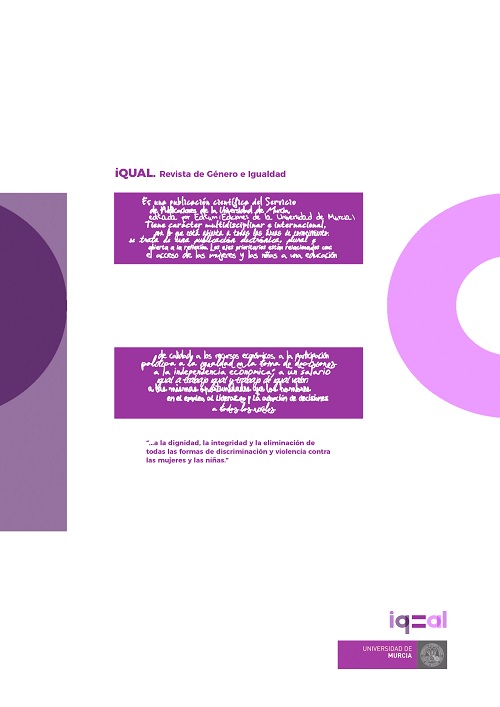Mitología contemporánea de la violación. Una revisión sobre la presencia de estereotipos de género en los tribunales españoles
Agências Suporte
- Ayudas para la formación de profesorado universitario (FPU)
- Ministerio de Ciencia e Innovación
- Gobierno de España
Resumo
El objetivo de este artículo es revisar los principales mitos de la violación y cómo afectan en el sistema judicial español. Desde una perspectiva socio legal se realiza una revisión bibliográfica de investigaciones teóricas y empíricas sobre los mitos de la violación. Las investigaciones actuales en España sobre mitos de la violación y sistema judicial son un corpus pequeño de estudios que abordan de forman exploratoria la cuestión, pero ponen de manifiesto que los estereotipos sobre la violencia sexual influyen en los tribunales a la hora de valorar la prueba y dictar sentencia, aunque la bibliografía analizada explora principalmente mitos sobre las víctimas y apenas se incide en los estereotipos sobre los violadores
Downloads
-
Resumo1398
-
Pdf (Español (España))714
Referências
Acale Sánchez, M. (2019). Violencia sexual de género contra las mujeres adultas: especial referencia a los delitos de agresión y abuso sexuales, Reus, Barcelona, España, Reus.
Aebi, M.; Caneppele, S.; Hashimoto, Y. Z.; Jehle, J. M.; Khan, T.; Kühn, O.; Lewis, C.; Molnar, L.; Þórisdóttir, R.; Smit, P., y corresponsales nacionales. (2021). European Sourcebook of Crime and Criminal Justice Statistics 2021 (6th ed.). Series UNILCRIM, (1).
Agirregomezkorta Ibarluzea, R.B; García Berrocal, M. L.; Pineda Lorenzo, M. & Tardón Recio, B. (2018). Las Violencias Sexuales en el Estado Español: marco conceptual y su abordaje en Andalucía, Madrid y Catalunya, Creación Positiva.
Amnistía Internacional. (2018). Ya es hora de que me creas. Un sistema que cuestiona y desprotege a las víctimas, Amnistía Internacional España.
Amorós, C. (1990). “Violencia contra las mujeres y pactos patriarcales” en V. Maquieira y C. Sánchez (comps.) Violencia y sociedad patriarcal, Madrid, España, Pablo Iglesias.
Ballesteros Doncel, E., & Blanco Moreno, F. (2021). «Yo sí te creo». Estereotipos sexistas hacia las víctimas de agresión sexual. Un estudio de caso sobre la Audiencia Provincial de Baleares (2018). iQual. Revista de Género e Igualdad, (4), 89–108. https://doi.org/10.6018/iqual.442801
Barcons Campmajó, M.; Bodelón, E.; Martínez, M. J.; Murillo, E.; Pisonero, A. & Toledo Vásquez, P. (2018). Las Violencias sexuales en el estado español: marco jurídico y análisis jurisprudencial. http://ddd.uab.cat/record/218654
Barjola Ramos, N. (2018). Microfísica sexista del poder: el caso Alcàsser y la construcción del terror sexual, Barcelona, España, Virus Editorial i Distribuïdora.
Barona Vilar, S. (2019). Retrato de la Justicia desde el pensamiento dialógico feminista. ¿Por fin ruptura del petrificado discurso androcéntrico? en Claves de la Justicia Penal. Feminización, Inteligencia Artificial, Supranacionalidad y Seguridad, Barona Vilar, S. (ed.), Valencia. http://dx.doi.org/10.2139/ssrn.3511485
Barrère Unzueta, M. & Morondo Taramundi, D. (2011). Subordiscriminación y discriminación interseccional: elementos para una teoría del derecho antidiscriminatorio. Anales de la Cátedra Francisco Suárez, 45, 15-42
Barrère Unzueta, M. (2018) Filosofías del Derecho antidiscriminatorio ¿Qué Derecho y qué discriminación? Una visión contra-hegemónica del Derecho antidiscriminatorio. Anuario de filosofía del derecho, 34, 11-42
Boeringer, S. B. (1996). Influences of fraternity membership, athletics, and male living arrangements on sexual aggression. Violence Against Women, 2(2), 134–147. https://doi.org/10.1177/1077801296002002002
Bornay, E. (1995). Las hijas de Lilith. Madrid: Cátedra.
Bourgois, P. (1996). In search of masculinity: Violence, respect and sexuality among Puerto Rican crack dealers in East Harlem. British Journal of Criminology, 36, 4312–4427
Brandariz Portela, T. (2021). Los mitos de la violación en el caso de ’La Manada’. Una crítica a la división patriarcal público / privado. Investigaciones Feministas, 12(2), 575-585. https://doi.org/10.5209/infe.76277
Braxton, B. (1973) Women, Sex and Race. A realistic view of sexism and racism. Verta Press:
Washington, D.C.
Brownmiller, S. (1975). Against Our Will: Men, Women, and Rape. Fawcett.
Buddie, A. M. & Miller, A. G. (2002). Beyond rape myths: A more complex view of perceptions of rape victims. Sex Roles, 45, 139-260. DOI:10.1023/A:1013575209803
Burgos García, A., Foradada Villar, M., Collectiu Punt 6, Oriols VadellIvet, I. y Zabala Guitart, P. (2018). 5.º Informe anual Noctámbulas 2017-2018. https://bit.ly/3BOqAlq.
Burt, M. R. (1980). Cultural myths and support for rape. Journal of Personality and Social Psychology, 38, 217-230. https://doi.org/10.1037/0022-3514.38.2.217.
Canto, J.M.; Perles, F.; San Martín, J. (2017). Culture of honour and the blaming of women in cases of rape / La cultura del honor y la inculpación de la mujer en casos de violación. Revista de Psicología Social, 32(1), 80–107. doi:10.1080/02134748.2016.1250488
Cazorla, C. (2021). Aproximación al perfil criminológico de las agresiones sexuales en grupo: un análisis a partir de su casuística jurisprudencial. e-Eguzkilore. Zientzia Kriminologikoen Aldizkari Elektronikoa, 6.
Chapleau, K., Oswald, D., & Russell, B. (2008) ‘Male rape myths: The role of gender, violence, and sexism.’ Journal of Interpersonal Violence, 23, 600–615. DOI: 10.1177/0886260507313529
Clay-Warner, J., & McMahon-Howard, J. (2009). Rape reporting: "Classic Rape" and the behavior of law. Violence and victims, 24(6), 723–743. https://doi.org/10.1891/0886-6708.24.6.723
Cobo, R. (2016). Un ensayo sociológico sobre la prostitución. Política y Sociedad, 53(3), 897-914. https://doi.org/10.5209/rev_POSO.2016.v53.n3.48476
Comack, E., & Peter, T. (2005). How the Criminal Justice System Responds to Sexual Assault Survivors: The Slippage between "Responsibilization" and "Blaming the Victim". Canadian Journal of Women and the Law 17(2), 283-309. . https://www.muse.jhu.edu/article/213365.
Curry, T. (1991). Fraternal bonding in the locker room: a profeminist analysis of talk about competition and women. Sociology of Sport Journal, 8, 119-135. https://doi.org/10.1123/ssj.8.2.119
Da Silva, T.; Woodhams, J. & Harkins, L. (2018). “An adventure that went wrong”: Reasons given by convicted perpetrators of multiple perpetrator sexual offending for their involvement in the offense. Archives of Sexual Behavior, 47, 443-456. 10.1007/s10508-017-1011-8
Davis, A. ([1981]/2005). Mujeres, raza y clase, Madrid, España, Akal.
Day, B. (1974) Sexual life between Blacks and Whites. The roots of racism. Collins
De Miguel, A. (2005). La construcción de un marco feminista de interpretación: la violencia de género. Cuadernos de Trabajo Social, 18, 231-248.
Delegación del Gobierno contra la Violencia de Género (2015). Macroencuesta de Violencia contra la Mujer. Madrid, Ministerio de Igualdad del Gobierno de España.
- (2018). Percepción Social de la Violencia Sexual. Madrid, Ministerio de Igualdad del Gobierno de España.
- (2020). Macroencuesta de Violencia contra la Mujer 2019. Madrid, Ministerio de Igualdad del Gobierno de España.
Despentes, V. (2007) Teoría King Kong. Tenerife, España, Ediciones Melusina.
Du Mont, J., Miller, K.-L., & Myhr, T. L. (2003). The Role of “Real Rape” and “Real Victim” Stereotypes in the Police Reporting Practices of Sexually Assaulted Women. Violence Against Women, 9(4), 466–486. https://doi.org/10.1177/1077801202250960
Eetessam Párraga, G. (2009). Lilith en el arte decimonónico: estudio del mito de la femme fatale. Signa 18, 229-249.
Fanon, F. ([1963]/1974) The wretched of the earth, London, UK, Penguin Books.
Fanon, F. ([1965]/1967) A Dying Colonialism, New York, USA, Evergreen.
Faraldo-Cabana, P.; Acale Sánchez, M.; Rodríguez-López, S. & Fuentes-Loureiro, M.A. (2018). La Manada: un antes y un después en la regulación de los delitos sexuales en España, Valencia, España,Tirant lo Blanch.
Farris, Sara R. (2017). In the name of women rights. The rise of femonationalism. Durham,
USA, Duke University Press.
Fileborn, B. (2016). Doing gender, doing safety? Young adults’ production of safety on a night out. Gender Place and Culture, 23(8), 1107–1120. https://doi.org/10.1080/ 0966369x.2015.1090413.
Franiuk, R., Luca, A., & Robinson, S. (2020). The Effects of Victim and Perpetrator Characteristics on Ratings of Guilt in a Sexual Assault Case. Violence Against Women, 26(6–7), 614–635. https://doi.org/10.1177/1077801219840439
Gerger, H., Kley, H., Bohner, G. & Siebler, F. (2007). The acceptance of modern myths about sexual aggression scale: Development and validation in German and English. Aggressive Behavior: Official Journal of the International Society for Research on Aggression, 33(5), 422-440. . DOI: 10.1002/ab.20195
Graham, K., Bernards, S., Abbey, A., Dumas, T. M., & Wells, S. (2017). When women do not want it: Young female bargoers’ experiences with and responses to sexual harassment in social drinking contexts. Violence Against Women, 23(12), 1419–1441. https://doi.org/10.1177/1077801216661037.
Graham, K., Bernards, S., Osgood, D. W., Abbey, A., Parks, M., Flynn, A., & Wells, S. (2014). “Blurred lines?” Sexual aggression and barroom culture. Alcoholism: Clinical and Experimental Research, 38(5), 1416–1424. https://doi.org/10.1111/acer.12356.
Gregory, J., & Lees, S. (1996). Attrition in rape and sexual assault cases. British Journal of Criminology, 36, 1-17.
Grubb, A. & Turner, E. (2012). Attribution of blame in rape cases: A review of the impact of rape myth acceptance, gender role conformity and substance use on victim blaming. Aggression and Violent Behavior, 17(5), 443–452. https://doi.org/10.1016/j.avb.2012.06.002
Harkins, L., & Dixon, L. (2010). Sexual offending in groups: An evaluation. Aggression and Violent Behavior, 15(2). 10.1016/j.avb.2009.08.006
Herton, C. (1965). Sex and Racism in America. Doubleday & Company, inc: New York.
Hill Collins, P. (2004) Black Sexual Politics. African Americans, Gender and the New Racism. London, UK, Routledge.
Jankowiak, W., & Ramsey, A. (2000). Femme Fatale and Status Fatale: A Cross-Cultural Perspective. Cross-Cultural Research, 34(1), 57–69. https://doi.org/10.1177/106939710003400104
Jankowiak, W., & Ramsey, A. (2000). Femme Fatale and Status Fatale: A Cross-Cultural Perspective. Cross-Cultural Research, 34(1), 57–69. https://doi.org/10.1177/106939710003400104
Javaid, A. (2015). Male Rape Myths: Understanding and Explaining Social Attitudes Surrounding Male Rape. Masculinities & Social Change, 4(3), 270–297. https://doi.org/10.17583/mcs.2015.1579
Kavanaugh, P. R., & Anderson, T. L. (2009). Managing physical and sexual assault risk in urban nightlife: Individual- and environmental-level influences. Deviant Behavior, 30(8), 680–714. https://doi.org/10.1080/01639620902854639.
Kovac, L. D., & Trussell, D. E. (2015). “Classy and never trashy”: Young women’s experiences of nightclubs and the construction of gender and sexuality. Leisure Sciences, 37(3), 195–209. https://doi.org/10.1080/01490400.2014.986347.
Larrondo, A.; Morales-i-Gras, J. & Orbegozo-Terradillos, J. (2019). Feminist hashtag activism in Spain: measuring the degree of politicisation of online discourse on #YoSíTeCreo, #HermanaYoSíTeCreo, #Cuéntalo y #NoEstásSola. Communication & Society, 32 (4). https://doi.org/10.15581/003.32.4.207-221
Lerner, G. (1972). Black Women in White America. A Documentary History. New York, USA, Pantheon Books.
Liarte Marín, C. & Bandrés Goldáraz, E. (2019) La objetividad y neutralidad de la información en la red. El tratamiento del Diario.es, ABC.es y El País.com en el juicio contra «la manada». Fonseca, Journal of Communication, 18, 119-140.
Lonsway, K. A., & Fitzgerald, L. F. (1994). Rape myths: In review. Psychology of Women Quarterly, 68, 133-164.
Lonsway, K. A., & Fitzgerald, L. F. (1995). Attitudinal antecedents of rape myth acceptance: A theoretical and empirical reexamination. Journal of Personality and Social Psychology, 68, 704-711.
MacKinnon, C. A. (1989). Toward a Feminist Theory of the State. Cambridge, Harvard University Press.
Marcos Casquero, M.A. (2009). Lilith: evolución histórica de un arquetipo. León, España, Universidad de León, Área de Publicaciones.
Matsuda, Mari J. (1987). Looking To The Bottom: Critical Legal Studies And Reparations. Harvard Civil Rights-Civil Liberties Law Review, 22.
McClintock, A. (1995). Imperial Leather: Race, Gender and Sexuality in the Colonial Contest. London, UK, Routledge.
Ministerio Fiscal (2020). Memoria anual de la Fiscalía General del Estado 2019. Fiscalía General del Estado. Madrid, Ministerio de Justicia.
Moor, A. (2007). When recounting traumatic memories is not enough: Treating persistent self-devaluation associated with rape and victim-blaming rape myths. Women & Therapy, 30, 19-33.
Morondo Taramundi, D. (2016). ¿Un nuevo paradigma para la igualdad? La vulnerabilidad entre condición humana y situación de indefensión. Cuadernos electrónicos de filosofía del derecho, 34.
Nguyen Vo, Thuy & Puello, Sergio (2016). Validez predictiva del SVR-20 y la Static-99 en una muestra de agresores sexuales en Cataluña. Centro de Estudios Jurídicos y Formación Especializada, Generalitat de Catalunya.
Payne, D. L., Lonsway, K. A., & Fitzgerald, L. F. (1999). Rape myth acceptance: Exploration of its structure and its measurement using the Illinois Rape Myth Acceptance Scale. Journal of Research in Personality, 33, 27-68.
Pernas, B.; Román, M.; Olza, J. & Naredo, M. (2000). La dignidad quebrada. Las raíces del acoso. Los libros de la Catarata, Madrid, España.
Quigg, Zara; Bigland, Charlotte; Hughes, Karen; Duch, Mariangels; Juan, Montse (2020). Sexual violence and nightlife: A systematic literature review. Aggression and Violent Behavior, 51(), 101363–. doi:10.1016/j.avb.2020.101363
Ranea, B. (2021). Desarmar la masculinidad. Los hombres ante la era del feminismo. Madrid: Libros la Catarata, Madrid, España.
Rodó-de-Zárate, María; Estivill y Castany, Jordi & Eizagirre, Nerea. (2019). La configuración y las consecuencias del miedo en el espacio público desde la perspectiva de género. Revista Española de Investigaciones Sociológicas, 167: 89-106. http://dx.doi.org/10.5477/cis/reis.167.89
Romero López, A. (2016). Herodías: la olvidada “femme fatale”. Signa: Revista De La Asociación Española De Semiótica, 25, 1007–1027. https://doi.org/10.5944/signa.vol25.2016.16941
Rubio-Martín, M.J., Blanco Moreno, F., y Ballesteros Doncel, E. (2022). ¿Qué queda del mito de la violación real? Un estudio de caso basado en análisis de sentencias judiciales. Revista Española de Sociología, 31 (4), a137. https://doi.org/10.22325/fes/res.2022.137
Sainz de Baranda Andújar, C.; Blanco Ruiz, M.; Adá Lameiras, A.; autora; Marugán Pintos, B. & San Segundo Manuel, R. (2020). Incidencia de la violencia sexual en la Comunidad de Madrid: acoso, abuso y agresión sexual, percepción y mitos asociados. Madrid, España, Instituto Universitario de Estudios de Género de la Universidad Carlos III de Madrid.
Saiz Martínez, M. y Morales Albarrán, O. (2020). Noches seguras para todas. Investigación-acción feminista participativa. Madrid, España, Ministerio de Sanidad, Consumo y Bienestar Social.
Saladin, L.A. (1993). Fetishism and Fatal Women: Gender, Power, and Reflexive Discourse. New York, USA, Peter Lang.
Sanday, P. G. (2007). Fraternity gang rape: Sex brotherhood, and privilege on campus, 2 nd ed. New York, USA, University Press
Scales, Ann (1992). Feminist Legal Method: Not So Scary. UCLA Women's Law Journal 2(0).
Segato, R.L. ([2003]/2010). Las estructuras elementales de la violencia. ensayos sobre género entre la antropología, el psicoanálisis y los derechos humanos. Prometeo.
Silvani, G. & Strukelj, V. (2005). The Legend of Salome in Nineteenth-Century Literature and Art. En Gender, Sexuality and the Family in Nineteenth Century Europe: Literary and Artistic Perspectives, Depicting, D. & R. Langford (ed.), 105-120. Bern, Switzerland, Peter Langs.
Smith, O., & Skinner, T. (2017). How Rape Myths Are Used and Challenged in Rape and Sexual Assault Trials. Social & Legal Studies, 26(4), 441–466. https://doi.org/10.1177/0964663916680130
Soleto, H.; Oubiña Barbolla, S.; Jullien de Asís, J.; Grané Chávez, A.; Diges Junco, M.; Galán González, C.; Pérez-Mata, N.; Fiodorova, A.; González Barrera, F.; Navarro Papic, I.; Gómez de Liaño, R.; López Jiménez, R.; Rodríguez Horcajo, D.; Torrecuadrada García-Lozano, S.; de Torres Guajardo, I.; Hernández Moura, B.; Carretero Morales, E.; autora, I.; Espinosa de los Monteros Zafra, R.; Ruiz López, C. & Peláez Devesa, M. (2021) Obstáculos que enfrentan las víctimas de delito sexual en las etapas del proceso penal: informe nacional. Informe Nacional España Proyecto RETREAT. Madrid. https://ssrn.com/abstract=3801956
Stoler, A.L. (2002). Carnal Knowledge and Imperial Power. Race and the Intimate in the Colonial Rule. California, USA, University of California Press.
Stuart, S. M.; McKimmie, B. M.; Masser, B. M. (2016). Rape Perpetrators on Trial: The Effect of Sexual Assault-Related Schemas on Attributions of Blame. Journal of Interpersonal Violence, () doi:10.1177/0886260516640777
Tang, K. (2000). Cultural Stereotypes and the Justice System: The Canadian Case of R. v. Ewanchuk. International Journal of Offender Therapy and Comparative Criminology, 44(6), 681–691. https://doi.org/10.1177/0306624X00446005
Tardón, B. (2017). La violencia sexual: desarrollos feministas, mitos y respuestas normativas globales. [Tesis doctoral, Universidad Autónoma de Madrid].
Temkin, J. & Krahé, B. (2008). Sexual assault and the justice gap: a question of attitude. Oxford & Portland, Oregon, USA, Hart Publishing.
Temkin, J. (2000). Prosecuting and Defending Rape: Perspectives from the Bar. Journal of Law and Society, 27(2), 219–248.
Toledo Vásquez, P. & Pineda Lorenzo, M. (2016). Abordatge Violencies Sexuals a Catalunya. Barcelona, España, Creación Positiva.
Toledo, P., Bodelón, E.,Tur, N & Martínez,M. (2017). Marc jurídic internacional, estatal i autoòmic de les violènces sexuals (matrimonis foçats, mutilacions genitals femenines, tràfic d´essers humans amb finalitat d´explotació sexual, assetjament i agressions sexuals). Barcelona, España, ANTÍGONA. Grup de Recerca de Drets i Societat en Perspectiva de Génere-UAB
Vall i Duran, C.; Vidal Escrivá, E.; Curell Mompó, L.; Cortés Viarnes, G. & Canyelles Gamudí, C. (2018). Violència Institucional i Revictimització en el sistema judicial i de denúncia de violències sexuals. Barcelona, España, Irídia y Ajuntament de Barcelona.
Walkowitz, J. R. ([1992]/1995). La ciudad de las pasiones terribles: narraciones sobre peligro sexual en el Londres victoriano. Madrid, España, Cátedra.
Ward, L.M.; Seabrook, R.C.; Manago, A. y Reed, L. (2016). Contributions of diverse media to self-sexualization among undergraduate women and men. Sex Roles 74, 12–23. https://doi.org/10.1007/s11199-015-0548-z
Waterhouse, G. F.; Reynolds, A.; Egan, V. (2016). Myths and legends: The reality of rape offences reported to a UK police force. The European Journal of Psychology Applied to Legal Context, 8(1), 1–10. doi:10.1016/j.ejpal.2015.04.001
Wekker, G. (2016). White innocence. Paradoxes of Colonialism. Durham, Duke University Press.
Woodhams, J.; Gillett, R & Grant, T. (2007). Understanding the factors that affect the severity of juvenile stranger sex offenses: the effect of victim characteristics and number of suspects. Interpersonal Violence, 22(2):218-37. https://doi.org/10.1177/0886260506295349
Direitos de Autor (c) 2023 Servicio de Publicaciones Universidad de Murcia

Este trabalho encontra-se publicado com a Creative Commons Atribuição-NãoComercial 4.0.








